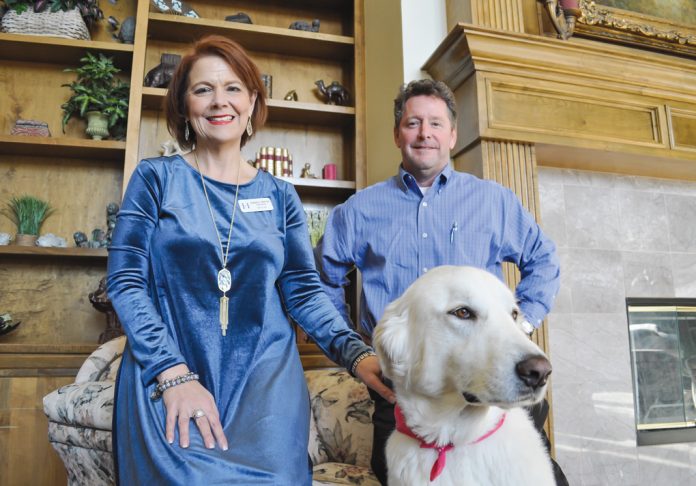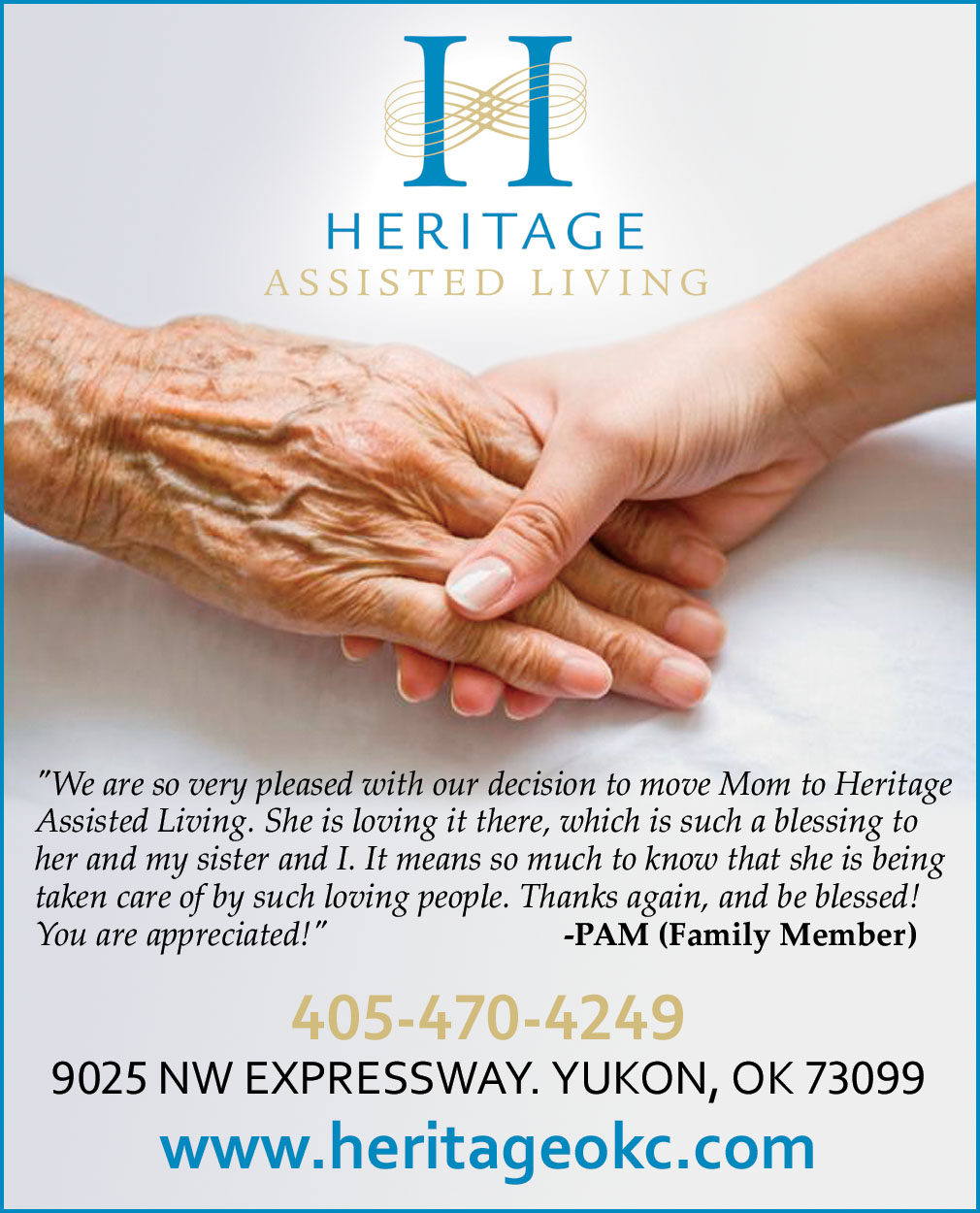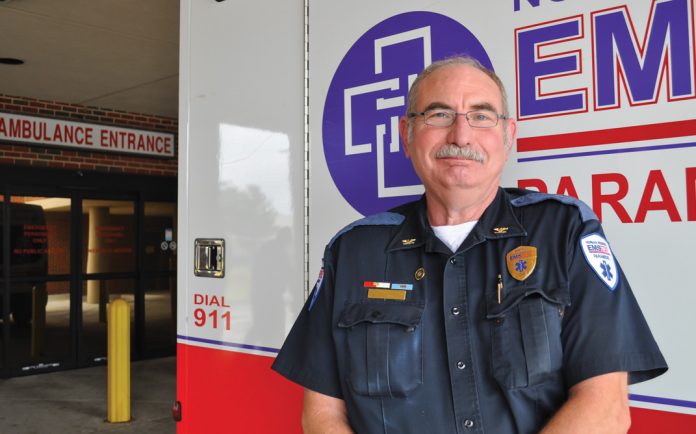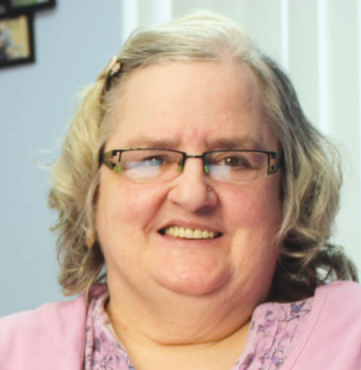Recipients of the annual Rural Fire Defense 80/20 Reimbursement Grants have been announced by Oklahoma Forestry Services. The grants provide funding for equipment purchases and fire station construction and are available through an application process to rural fire departments which serve populations of less than 10,000.
“There is a great need for equipment and station construction by our rural fire departments,” said George Geissler, director, Oklahoma Forestry Services. “These departments are the first line of defense for their communities and we would like to be able to offer assistance to more departments.”
A total of $125,000 was available for the program this year and departments were eligible to receive up to $30,000 for fire department construction and up to $20,000 for fire equipment purchases. The grants provide reimbursement of up to 80% of the total amount of projects, with fire departments receiving reimbursement after the purchase or constructions costs have been paid. Sixteen departments were selected to receive the grants this year.
The grants are authorized by Governor Mary Fallin, funded by the Oklahoma Legislature and administered by the Oklahoma Forestry Services, a division of Oklahoma Department of Agriculture, Food & Forestry. Oklahoma’s Rural Fire Coordinators grade the applications and select the recipients.
Rural fire departments which have been awarded grants this year include: Boulanger Rural Fire Department; Butler Volunteer Fire Department; Caddo Fire Department; Blackwell Fire Department; Harrah Fire Department; Cordell Volunteer Firefighters Association; Darwin Volunteer Fire Department; Green Country Volunteer Fire Department; Walters Fire Department; Jacktown Fire Department; Monroe Volunteer Fire Association; Ochelata Volunteer Fire Department; Oglesby Civil Defense Volunteer Fire; Sam’s Point Volunteer Fire Department; Meeker Fire Department; Rosston Volunteer Fire Department and Wilson Community Volunteer Fire Association.
For more information about the grants and recipients visit the Oklahoma Forestry Services website at www.forestry.ok.gov or call 405-288-2385.
Rural fire department grants awarded by Oklahoma Forestry Services
First Two Flu Deaths of the Season Reported
The Oklahoma State Department of Health (OSDH) announced the first two deaths caused by the flu in the state. Both deaths occurred in patients who were over the age of 65. There have been 105 influenza-associated hospitalizations reported statewide.
The number of flu cases is relatively high for this time of year, and public health officials are concerned there will be a high risk of spreading the flu during the holiday season. The highest number of flu-related hospitalizations has occurred among those who are older than 50 years of age, as well as children younger than 5, which are both groups at greater risk of experiencing severe illness and complications due to flu.
The OSDH reminds the public that there are still several months left in the flu season. The single best way to protect against flu and its consequences is to get the flu vaccine. Many local county health departments, pharmacies and health care providers have vaccine and health officials urge everyone 6 months of age and older to get the vaccine to protect themselves and those around them from influenza, especially babies too young to receive a vaccination. It takes about two weeks after getting a flu shot for a person’s immune system to respond and provide defenses against influenza viruses.
Those who already have the flu can spread it to others even before they feel sick. One may have the flu if they have some or all of these symptoms: Fever, Cough, Sore throat, Runny or stuffy nose, Body aches, Headache, Chill, Fatigue
It is important for those experiencing flu-like symptoms to consult with a health care provider as soon as possible. Antiviral drugs may be prescribed to treat the flu. These drugs work better for treatment when started within 48 hours of noticing symptoms. Influenza antiviral drugs may also be indicated as a prevention measure to protect those who have just been exposed to someone diagnosed with influenza and are especially vulnerable.
Certain people are at greater risk of serious flu-related complications. Young children, elderly persons, pregnant women and people with some long-term medical conditions are reminded to contact their health care provider as soon as they develop flu symptoms.
OSDH recommends staying home for at least 24 hours after a fever is gone. Avoid going to work, school, social events and public gatherings as well as traveling and shopping. The fever should be gone without the use of a fever-reducing medicine, such as acetaminophen before returning to a regular routine. To prevent the spread of the flu, the public is reminded to cover coughs and sneezes with a tissue and wash hands often.
For more information about influenza and activity updates, visit the Ok Flu View at flu.health.ok.gov.
A place to call home

by Bobby Anderson, Staff Writer
Heritage Assisted Living has been in Curtis Aduddell’s family for 17 years.
The director realizes when he comes to work every day he’s walking into someone’s home.
He’s proud of that. And walk the halls of the Yukon residence for a few minutes and you’ll quickly see he’s not the only one.
“More laughter going on here than any other facility around, I’ll bet you,” said resident Jane Carter.
“We do have fun,” resident Ron Kirby chimed in. “It’s the reason to live. That’s what it’s all about. When you’re happy you live longer.”
There’s life in these hallways.
The sound of people laughing.
The smell of chicken enchilada soup simmering on the stove in preparation for dinner.
FAMILY DIFFERENCE
Aduddell became a nursing home administrator in 1993 in Texas. When the opportunity arose to move back to Oklahoma he jumped on it.
His brother and father approached him with a plan to open several assisted living facilities. The family built Heritage Assisted Living from the ground up and Aduddell has been at 9025 Northwest Expressway ever since.
Joan Dark’s residence is just 10 feet down the hall from Aduddell’s office.
His door is alway open, usually with Chief Canine Officer Cotton’s head poking out. Aduddell’s affectionate, gentle and patient Great Pyrenees knows every resident by sight and visits with them on a daily basis.
In 2015, Dark sold her house and moved into independent living. Less than a year later she realized the move didn’t solve the day-to-day chores of cleaning, cooking and shopping.
A friend suggested Heritage Assisted Living.
“I love it here,” Dark said.
And one of the things she loves is the access she has to the man in charge.
She’s used that access on a couple occasions but mostly she pops in just to say hello.
“A lot of people like the fact they can go to somebody that can at least give them an answer. Whether the answer is yes, no, this that or the other you don’t have to run it up a corporate chain of command,” Aduddell said.
“We do it because we love the seniors and we love what we do. That’s my goal. Open door – absolutely.”
SMOOTH TRANSITION
The open door policy is just one of the amenities new residents are offered when Director of Admissions Kimberly Brinner begins the discussion of moving in.
“We get a lot of information before people come in and find out their likes and dislikes,” Brinner said. “We try to pair them up with someone here who is very similar.”
From that information a myriad of things begin to fall into place.
“They feel comfortable. They know there are people they can go to talk to over and over again,” Brinner said. “We know this is going to be hard. The first six weeks are always bumpy, no matter wherever they go.”
“But it’s bumpy because their entire world has just turned upside down. We want to make sure during that time we’re here for them 100 percent.”
That’s where the hospitality committee comes in. Sharing stories, memories, tips and feelings of their own personal transitions oftentimes brings it home to people that they don’t have to go through this phase alone.
Residents are encouraged to take ownership at Heritage. Whether it be serving on resident committees or leading in other ways the message is clear: Heritage is your home.
“We work here. You live here,” Brinner said. “We’re working in your home. We want to know what you want us to do in your home. We don’t want to cross that line when we’re in your home. You tell us what you need us to do to make your life better.”
“The thing I always stress is that we’re a family-owned facility but we’re a family here. My mom lives here.”
Dinnertime is a special time at Heritage – largely because it’s driven by what residents want.
The food council meets monthly with Chef Felipe Castillo to help craft the menu.
Special requests are made and family recipes are shared with Castillo so he can share with everyone.
A few years back, residents even opted to restructure dining times and implement reserved seating.
“They wanted that. It’s not for our benefit,” Aduddell laughed. “They wanted it to get to know the people at their table.”
Remodeling has already begun at Heritage. A bistro will open along with a workout facility. More open reading areas will be offered.
Granite countertops and new flooring are also being installed.
Staff longevity reigns at Heritage. Director of Nursing Jodie Spradlin has several night staff that have worked at Heritage for 17 years.
Many others are reaching a decade of service to residents.
“People come and stay,” Aduddell said. “We just try to hire caring and compassionate people. I think we’ve done a good job in that.”
They’ve also done a good job of making a home.
To find out more information you can call Brinner at 405-470-4249 or go online to
www.heritageokc.com.
Dec/Jan AARP Drivers Safety Classes
Date/ Day/ Location/ Time/ Registration #/ Instructor
Dec 7/ Thursday/ Okla. City/ 9 am – 3:30 pm/ 951-2277/ Varacchi
Integris 3rd Age Life Center – 5100 N. Brookline, Suite 100
Dec 8/ Friday/ Okla. City/ 9 am – 3:30 pm/ 951-2277/ Edwards
S.W. Medical Center – 4200 S. Douglas, Suite B-10
Dec 16/ Saturday/ Midwest City/ 9 am – 2 pm/ 473-8239/ Williams
First Christian Church – 11950 E. Reno Ave.
Jan 4/ Thursday/ Okla. City/ 9 am – 3:30 pm/ 951-2277/ Varacchi
Integris 3rd Age Life Center – 5100 N. Brookline, Suite 100
Jan 8/ Monday/ Midwest City/ 9 am – 3:30 pm/ 473-9239/ Williams
First Christian Church – 11950 E. Reno Ave.
Jan 9/ Tuesday/ Yukon/ 9 am – 3:30 pm/ 350-7680/ Kruck
Dale Robertson Center – 1200 Lakeshore Dr.
Jan 9/ Tuesday/ Midwest City/ 9 am – 3:30 pm/ 691-4091/ Palinsky
Rose State Conventional Learning Center – 6191 Tinker Diagonal
Jan 10/ Wednesday/ Mustang/ 9 am – 3:30 pm/ 376-3411/ Kruck
Mustang Senior Center – 1201 N. Mustang Rd.
Jan 12/ Friday/ Okla. City/ 9 am – 3:30 pm/ 951-2277/ Edwards
S.W. Medical Center – 4200 S. Douglas, Suite B-10
Jan 23/ Tuesday/ Okla. City/ 9 am – 3:30 pm/ 773-6910/ Kruck
Healthy Living – 11501 N. Rockwell
The prices for the classes are: $15 for AARP members and $20 for Non-AARP. Call John Palinsky, zone coordinator for the Oklahoma City area at 405-691-4091 or send mail to: johnpalinsky@sbcglobal.net
Making a difference
story and photos by Bobby Anderson, Staff Writer
For the last four decades Eddie Sims has kept a watchful eye on the citizens of Cleveland County.
You’ll probably never meet him but if you or a loved one ever requires emergency medical attention it will come as a result of the work put in by Sims and his staff.
The EMSSTAT manager and paramedic has around 100 employees who staff the emergency medical services for Norman, Moore, and adjacent rural areas of Cleveland County along with the northern half of the township of Goldsby.
That means Sims’ crew operates 13-14 ambulances on most days and is responsible for the lives of some 200,000 people at any given time.
Then there’s the athletic events.
“Luckily they’re planned,” Sims smiled. “It’s not a summer concert to benefit the tornado victims in the middle of July which I never want to see again.
“We cover the vast majority of OU athletics and a lot of community events in both cities. I live my life around OU. I don’t leave town for OU game days, graduation or medieval fair. There’s things you have anchored and live your life around those.”
When the football season begins and nearly 90,000 people descend on Gaylord Family Oklahoma Memorial Stadium for a daytime game a medical call for assistance comes in every 90 seconds.
Sims grew up in Miami, Florida with older parents. His father was diagnosed with cancer on his spine when Sims was 11.
He took care of his parents from then on.
Growing up in the early 1970s watching firefighters John and Roy man Squad 51 on the hit TV drama Emergency, Sims was hooked.
“During that time was when EMS was born. That’s what I wanted to do,” Sims said. “We used to sit around and watch it. I was used to being up 24 hours a day taking care of (my father) and responding to stuff. My mom had issues to where she really couldn’t do it and I was an only child.”
“I got involved with medicine and helping people before I really had a choice and it was really what I wanted to do.”
When he was old enough to get a job he found the local market tough to break into without a military or minority background.
“They wouldn’t even accept applications so when I was 14 or 15 I started chasing hurricanes,” he said. “In that process I met the director of the severe storms lab (in Norman) who invited us to come chase tornadoes.”
That began a routine where every spring he would fly to Oklahoma to chase storms.
He eventually settled in Norman and was among the first group to establish medical services under the Norman Police Department.
“When we started Norman probably had 50,000 or 60,000 people in it,” Sims said. “The culture in Oklahoma was ‘take me to the hospital now, you people don’t need to be doing anything to me.”
“There was a lot of public education. Being in a police system it was kind of a unique opportunity that a lot of us that had concerns how the police would integrate into an emergency medical system, it turned out to be an absolutely wonderful fit.”
In 1995, the City of Norman shuffled its emergency services and put them under the umbrella of the Norman Regional Health System.
“Again, that was a great opportunity because the resources the health system had were much greater than the city was willing to contribute,” said Sims, whose agency boasts higher than national average survival rates for patients experiencing cardiac arrest. “Medically, in 1978 if you had a heart attack we tried to get you to a hospital. If you had a second heart attack man you were lucky but you didn’t have much heart left and your quality of life went down.”
“If you had a stroke it really wasn’t an emergency because there wasn’t anything anybody was going to do for you.”
Within the last 10 years that all changed.
“We can get you to a hospital and the people in the cath lab can remove the blockage and you can walk out three days later healthier than when you started,” Sims said. “If you have a stroke and .. we take you to a stroke center and two days later you may have no residual effects at all.”
“The difference that EMS and emergency medicine has made over the four decades I’ve been doing this is amazing.”
Oklahoma Cityans Will Hear Better
By Ron Hendricks
The first hearing loop installed in the metro is located in the newly renovated Nichols Hills City Council chambers where the users of hearing devices will be able to hear all that goes on in meetings and conferences. A ribbon cutting ceremony with many ‘dignitaries’ and guests celebrated the completion of the installation.
The second LOOP installation in Oklahoma City has also just been completed in the OKC Civic Center Music Hall. The hearing loop system is hard wired into the auditorium and will transmit sound directly into a hearing aid or Cochlear implant with a “T” coil. When you visit the Civic Center for a musical show or concert this fall, you may be surprised by what you hear!
Central Oklahoma Chapter of the Hearing Loss Association of America is proud to be a part of the “Oklahoma City Hearing Loop Initiative.” Our member, Ana Covey and her company, Assist2Hear are responsible for these installations. COCHLAA, with Ana and Assist2Hear and are looking forward to many more installed locations to help those suffering with hearing loss. After all, it is an ADA requirement, that facilities offering public access where sound is integral to the space, must offer hearing assistance to those who need it and the hearing loop is by far, the user-preferred system.
Please visit with your audiologist or hearing aid specialist to make sure your hearing aid or Cochlear device is hearing loop ready by activating the telecoil (T-coil) option available in most aids.
If you know of businesses that have this kind of need, please feel free to contact COCHLAA at the Hearing Helpers Room, 405-717-9820 or visit our website, www.okchearingloss.org . You can also contact Ana at ana@Assist2Hear.com or (405)640-5152 for any questions about hearing loops.
Join the Hearing Loss Association and help us get our city “get in the loop.” Hearing Loss Association of America Central Oklahoma Chapter holds meetings twice a month. Second Mondays, 6:30-8PM and the third Thursdays, 1:30-3PM at Lakeside Methodist Church, 2925 NW 66th St. The meetings are open to the public, no admission charge.
INTEGRIS Employees Toss Turkeys to Regional Food Bank
INTEGRIS Health and its employees have once again donated turkeys from their annual Turkey Toss to the Regional Food Bank of Oklahoma. This year, 865 turkeys were donated and distributed to fellow Oklahomans who have inconsistent access to nutritious food.
“We consider ourselves blessed to work for an organization that values our employees and is willing to reward them in this special way,” said Bruce Lawrence, president and CEO of INTEGRIS Health. “Donations made to the Regional Food Bank allows INTEGRIS to live our mission by supporting our community through giving to those in need this holiday season.”
INTEGRIS Health traditionally hands out turkeys to their employees in November as a way of ‘giving thanks’ for their hard work and dedication throughout the year. Many employees ‘pay it forward’ by donating their turkey to the Regional Food Bank.
“Having a meal to share is often out of reach for many of our Oklahoma neighbors,” said Katie Fitzgerald, chief executive officer of the Regional Food Bank. “There are too many of our neighbors – people you may even know – who are quietly living with hunger. Thanks to INTEGRIS Health and all of their wonderful employees, hundreds of families will now enjoy a nutritious holiday meal together.”
This year alone, INTEGRIS, and its employees, donated 25,850 pounds of food through its Turkey Toss and Gov. Mary Fallin’s Feeding Oklahoma Drive. In total, 7,626 turkeys have been donated to the Regional Food Bank since INTEGRIS Health began the partnership in 2010. The majority of Oklahomans served by the Regional Food Bank are chronically hungry children, seniors living on limited incomes and hardworking families struggling to make ends meet.
It’s not too late to make a difference this holiday season. Thanks to a generous matching challenge from APMEX.com, the Cresap Family Foundation and Chesapeake Energy Corporation, every gift we receive through Jan. 15 will be matched, dollar for dollar – up to $600,000 – for a total impact of $1.2 million. To make a donation call 405-600-3136 or visit regionalfoodbank.org/donate.
Inspiring Generations to Devote Lives to Care, Kindness, Respect

Salmeron career a combination of nursing and education
by Traci Chapman, Staff Writer
Oklahoma City University Dean of the Kramer School of Nursing Lois Salmeron has ascended the heights during her life – as a nurse, an educator, a wife and mother and as a professional who successfully navigated a journey few women of her generation did.
“I have always wanted to be a nurse – my father encouraged me to go into medicine,” Salmeron said. “However, in those days to combine being married and having a family for women was a rarity.”
Despite that fact, the young woman decided to follow her instincts – Salmeron first attending nursing school at St. Francis Hospital in Wichita, Kansas. Graduating in 1962, she and her husband married while she was a nursing student and he was completing his residency in anesthesiology.
With a diploma from St. Francis that allowed Salmeron to pass the state board and become a registered nurse, her first staff position was in the maternity acute care unit of the hospital where she attended nursing school. But, while she had a good start at the Wichita facility, it was only the start.
Her path veered in a different direction when Salmeron’s husband was offered a staff position at then-Baptist Hospital; the couple and their two children moved to Oklahoma City. It was after that move that Salmeron’s career really began to blossom.
She began her Oklahoma healthcare career as a staff nurse in Deaconess Hospital’s labor-delivery and mother-baby units – and, later, as nurse educator for Deaconess personnel hospital-wide.
That position showed yet another facet of nursing that would become a passion – education. That would be very important in the late 1960s when Mercy Hospital approached Oklahoma State University-OKC with a proposal.
It was a time when, like with Salmeron’s own experience, hospitals were the source of nurse education. Mercy’s idea to transfer its program to OSU-OKC helped spur a major change in the way nurses would obtain their degrees, and Lois Salmeron would be on the forefront of that movement.
“I was one of the first three faculty to begin that program,” she said. It was a program she would remain with for more than three decades, the last nine of her 31 years at OKC-OSU as division head of health services. While there, Salmeron also in the late 1980s spearheaded a nursing distance learning system for the Oklahoma panhandle area and based at OSU-OKC.
The now established nursing educator never stopped learning herself. Salmeron earned bachelor’s and masters of science degrees from University of Oklahoma; she obtained a master’s of arts in teaching at Oklahoma City University and Oklahoma State University Doctorate of Education with adult education focus.
In 2001, Salmeron was at a turning point, however. She retired from OSU-OKC, but the ongoing nursing shortage convinced her to remain in the field. Oklahoma City University’s Kramer School of Nursing had room to grow – and a place for Salmeron to help it do just that. For four years, she served as an adjunct professor, but that was far from the extent of her contribution to OCU.
“As KSN was growing in numbers of nursing students, I was asked to apply for the assistant dean position – I was chosen for that position in July 2005,” Salmeron said. “I advanced to be the associate dean in two years.”
When the dean took a semester off in the spring of 2013, Salmeron was named senior associate dean in charge. In June, when longtime Dean Marvel Williamson retired from the college, Salmeron was appointed interim dean.
Salmeron became Kramer School of Nursing Dean in January 2014, becoming responsible for the entire nursing department – “budget, enrollment, recruitment of students and faculty, hiring staff and faculty, working with the other schools on campus, service to the university and the community, fund raising for the department, strategic planning, awareness of state and national guidelines that must be followed for approval and national accreditation, continuing education for faculty and staff, maintaining a positive culture for faculty, staff and students to succeed,” Salmeron said. “These are just some of the responsibilities of the dean.”
While her position meant a full spectrum of responsibilities, it didn’t diminish the dean’s love of nursing and teaching – something she said she didn’t want to completely relinquish. She therefore chose to retain a part of what brought her to Oklahoma City University in the first place.
“I teach one PhD course every Fall semester called Nursing Education Administration,” the dean said. “It is rewarding and challenging to work with these adult students sharing some of the components of what is required to lead a nursing education program.”
Salmeron’s wide-ranging experience has served her – and the college – well. Last year, OCU began a distance learning program in Duncan that harkened back to her 1980s panhandle experience.
Like much of Salmeron’s career, the Duncan program is just one of several milestones of the past that have inspired achievements in the present. And, Salmeron herself has been a source of inspiration for thousands of students who know how much she has achieved in a world very different from today’s nursing opportunities – and her work has spurred countless awards, including the Distinguished Professional Service Award from the Association of Women’s Health, Obstetric and Neonatal Nurses, a nonprofit aimed at promoting the health of women and newborns.
Salmeron was also the first nurse to ever receive the American College of Obstetricians and Gynecologists’ Graham White Award and was in 2003 inducted into the Oklahoma Higher Education Hall of Fame.
Salmeron has achieved as much in her personal life as she has in her profession – she and her husband have been married for 57 years and live in the home they built and moved into in 1968. The couple has three grown children who understood their mother’s education advocacy – a son and daughter are PhDs, while a second son earned his MBA and has his own financial management company. His siblings are a researcher in plant molecular biology and a clinical psychologist in private practice.
“My husband grows orchids, has his own greenhouse, is retired, but supports my passion of educating the next generation of nurses,” Salmeron said.
At 77, while many people would be looking to slow down or take an easier path, those around her said Salmeron shows no sign of doing that. Juggling a myriad of responsibilities at work, the dean also gives back to the community – she volunteers on several state and national nursing committees and serves on several boards, including Mercy, Oklahoma City-County Health Department and Oklahoma Higher Education Heritage Society; she is also an Accreditation Commission for Education in Nursing peer reviewer.
Salmeron’s hands on approach shines through in all of her endeavors – her work, charitable and volunteer endeavors and her personal life – and it’s something illustrated by her view of the school and its culture, what she called the Kramer Way.
“My priority at KSN is to create the positive culture in which the faculty and staff can guide the nursing students to be successful and ready for the professional responsibilities that they will have,” Salmeron said. “The Kramer Way means we all try to live a life that values caring, kindness and respect.”
ASK VICKI: Q. My husband and I are both self employed and have Obamacare (aka The Affordable Care Act,ACA).
Q. My husband and I are both self employed and have Obamacare (aka The Affordable Care Act,ACA). Even though we make a good income, it fluctuates but we do not qualify for any subsidies. Our premium has jumped to over $1000 per month with a deductible of $6500!! There is nothing affordable about raising our premium 76%. Our stress level has also jumped 76%. What is happening to hard working people whose incomes do not jump even close to 76%.
Janet and Kyle
A. Oklahoma has only one health care provider, Blue Cross and Blue Shield (BCBS). All the other insurance carriers have left Obamacare. When losses exceed premiums, the only options are to stop doing business with this group of Oklahomans or raise premiums.
According to John Doak, Oklahoma Insurance Commissioner, since the 2014 implementation of the ACA, BCBS combined losses are more than $300 million. So they can exit this group of people, leaving them with no coverage or they can skyrocket the premiums.
Subsidies sound great but not everyone qualifies for them. It sounds like you and your husband fall into the group of people that will have to find a way to make more money on your own. As if you didn’t have enough stress, now this.
Oklahoma is an unhealthy state. According to Business Insider, Dec 2013, Oklahoma ranks #7 on the 10 Unhealthiest States List. Obesity rates are high in our state. The amount of public funding available for health care has dropped 40% in the past two years. Addiction rates are high.
Options for those on Obamacare are limited but the following are: suggestions:
1. Check to see if you qualify for any subsidies.
2. Don’t have insurance and pay the penalty at tax time.
3. Spend less – can you modify your budget?
4. Work more – not good for mental health/physical health
5. Lower stress by staying as healthy as possible
*exercise–get out and move your body *nutrition–choose healthy options, avoid impulse eating *laugh — there are funny moments — seize them *sleep — most people are sleep deprived.
Maybe you can motivate the unhealthy Oklahomans to put down their fork and put their walking shoes on. This is a serious issue with a serious consequence and a domino affect that could be disastrous.
DARLENE FRANKLIN: THE ORIGINAL PROMISE KEEPER
By Darlene Franklin
Merry Christmas? Not always. For many, it’s the loneliest time of year. Merry Christmas? Not always. For many, it’s the loneliest time of year. How do you read “Godisnowhere?” Many cheer that God is now here. Others wander in the darkness of “God is nowhere.” Some still wonder if Emanuel, God with us, has ever come. God not only makes promises. He transforms, fulfills, and perpetuates them. PROMISES GIVENIn the 21st century, Christians are tempted to question why people didn’t recognize Jesus as the Messiah at His birth. We don’t think about how long Jews had waited waiting for Emanuel to be born, ever since the birth of their nation, a promise that extended back to the Garden of Eden.Fifty-three years ago, my ten-year-old self said “I will” when the preacher asked, “who will go?” I fbelieved I was supposed to serve as a music missionary to Mexico.Our southern neighbor was pretty exotic to someone from Maine. I studied Spanish on my own until I got to high school and pursued advanced degrees in Bible and music.Did I ever get to Mexico? Yes, for eight glorious weeks one summer while I was in college. My dream of fulltime service ground down over the years. Financial and family difficulties intervened, and I found myself too old and unfit. I gave up, but God didn’t. When I moved west, Mexicans worked in fast-food restaurants, did my hair, and became my neighbors, friends, and co-workers. They accepted my halting attempts at Spanish with delight. When I didn’t get to Mexico, God brought Mexico to me. PROMISES TRANSFORMEDGod did more than bring Mexico to me. He turned the tables on me. A couple of weeks ago one of my nursing home aides, Maria Ochoa, helped me get ready for the day. Spanish Catholic music played on her phone, and I sang along. She showed me the lyrics on the screen. For ten minutes, we told the gospel through endless verses. It was a powerful time of worship. Maria had switched roles and ministered to me. The Lord took the promise to bring me to Mexico and transformed it into something even more beautiful. Similarly, the Messiah who arrived didn’t match what people expected. Instead of a King to sit on David’s throne, God sent the Lamb who would take away the sins of the world and rule over a heavenly kingdom of people from every tribe and tongue and nation. PROMISES FULFILLEDThose first century Jews had it partly right. The Day of the Lord is coming and His Kingdom will be established on earth as it is in heaven. But they missed the bits about the humble servant who would suffer and die (Isaiah 53:5). Jesus fulfilled those prophecies. Sometimes a promise happens in stages. The fact we didn’t get everything we expected doesn’t meant those things will never come to pass. Take the book I’m working on now. I’ve been to compose prayers from Genesis to Revelation. I’m jumping for joy because God called me, promised me, that I would be writing a devotional book over twenty-five years ago. After my nonfiction proposals got rejected repeatedly, I decided God wanted me to write fiction. I’ve been blessed with many novels, and have contributed devotions to books now and then. Over the past eighteen months, God has opened one door after another to write nonfiction. And now God gave me this this awesome, almost scary, gift and assignment. Praise Him.PROMISES PERPETUATEDGod gives every generation enough signs to believe the Lord is returning in their generation. In my youth, we looked at the restablishment of Israel as a nation for the first time AD 70 (in 1948). I spent my young adult years watching for the Lord’s return. If it happened within a forty-year generation of Israeli nationhood, He would come in 1988. When it didn’t happen, I knew I had figured wrong. Perhaps the biblical promises to bless the righteous to a thousand generations works like that. That’s a promise that stretches beyond the family I can imagine, to places I’ve never been-until the Lord’s return. God will fulfill every one of His promises. It’s only a question of when.Sponsored by Darlene Franklin. Best-selling hybrid author Darlene Franklin’s greatest claim to fame is that she writes full-time from a nursing home. Mermaid Song is her fiftieth unique title! She’s also contributed to more than twenty nonfiction titles. Her column, “The View Through my Door,” appears in four monthly venues. Other recent titles are Christmas Masquerade and Maple Notch Romances Eight Couples Find Love You can find her online at: Website and blog, Facebook, Amazon author page









